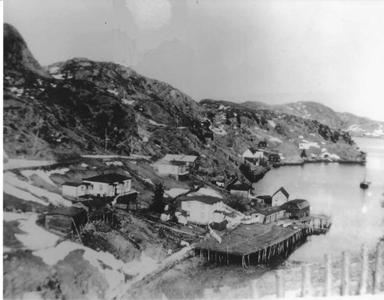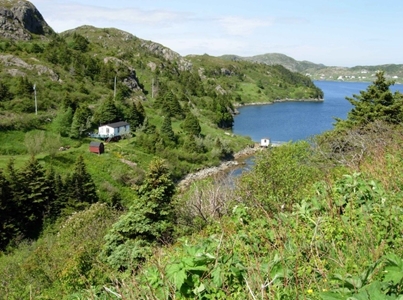by Ian Hammond, MD, FACR
The Newfoundland Tsunami of 1929
 Figure 1: Wandsworth, 1950s |
 Figure 2: Wandsworth, 2007 |
My mother and her five siblings grew up on the Burin Peninsula of Newfoundland in the small outport of Wandsworth. My uncle Joseph was the youngest sibling, age nine when the deadly tsunami struck on Nov. 18, 1929. The natural disaster devastated several villages, killing 28 people and wiping out the region’s lifeblood: the cod-fishery1.
Apart from damage to its fishing wharves or “stages” as they were known locally, Wandsworth was miraculously spared. It lay in a sheltered harbor, protected by points of land and islands that dampened the enormous wave, and its homes were built sufficiently up the hillside to escape being washed away.
Forty years later, Wandsworth was no more, and most of its inhabitants moved to nearby Epworth in a controversial government resettlement program during the mid-twentieth century. I revisited the area in 2007, and with the aid of my cousin, Robert Mitchell, obtained earlier photos for comparison (Figures 1 & 2).
Shortly before my uncle Joseph died, geographer Claire Samson2 published an excerpt of his childhood recollections, which included the following quote:
“Some thought that a large airplane had passed overhead, while others believed that the world was coming to an end ... children were crying, women were screaming, and everyone began to scramble to reach higher ground.”2
This story evokes many thoughts, including ruminations on the resilience of the human spirit. In spite of centuries of hardship, Newfoundlanders are renowned for their kindness and hospitality, as exemplified in the musical ”Come From Away.”
- Linden MacIntyre. The Wake. HarperCollins Publishers Ltd., 2019.
- Joseph Mitchell (interview) in Patrick L., Abbott P.L., Samson C. Natural Disasters, first Canadian edition. McGraw-Hill Ryerson, 2009. p. 149.